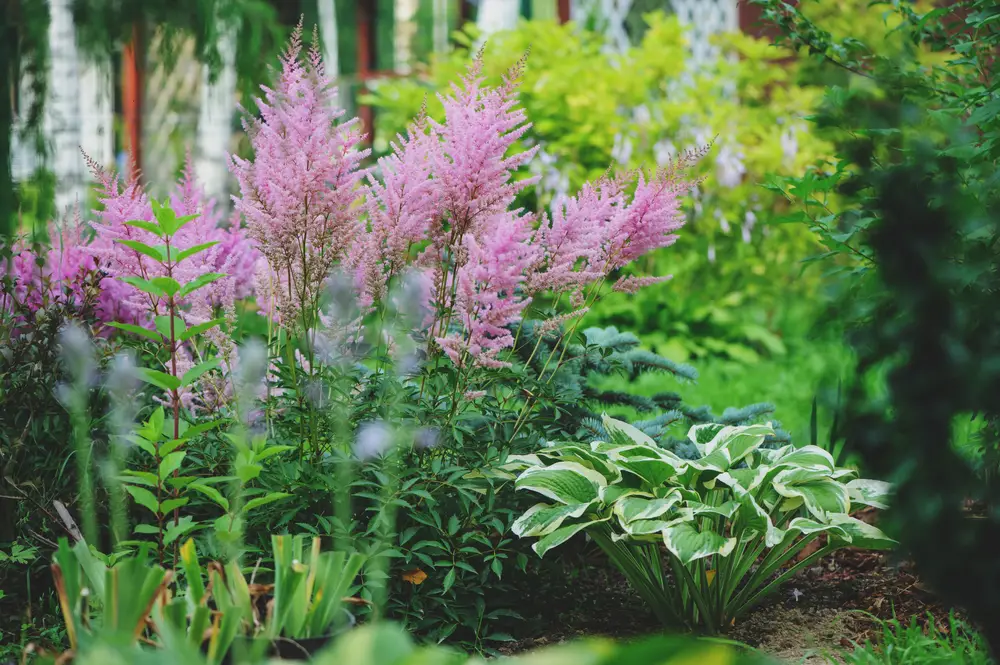Mention the words “shade garden” and people tend to conjure up an image of rather dull and uninteresting spaces. Poor old shade gardens often get a bad rap!
Rather than being bland and boring, shade gardens offer an array of plants including all tones of greens, silver, creamy white, yellow, purple, pink and orange. Their combinations create a planted oasis to escape the summer’s intense heat. They can give a garden a subtle elegance full of meditative beauty.
The list of plants for shade includes a wide selection of interesting foliage textures and colors. It also includes flowering shrubs, perennials, and annuals that provide interest throughout the season.
Once you understand what shade is, and how to design a garden space within it, the results can be spectacular. That’s what I’m going to share with you today!
Shade Gardening 101: What Is Shade?
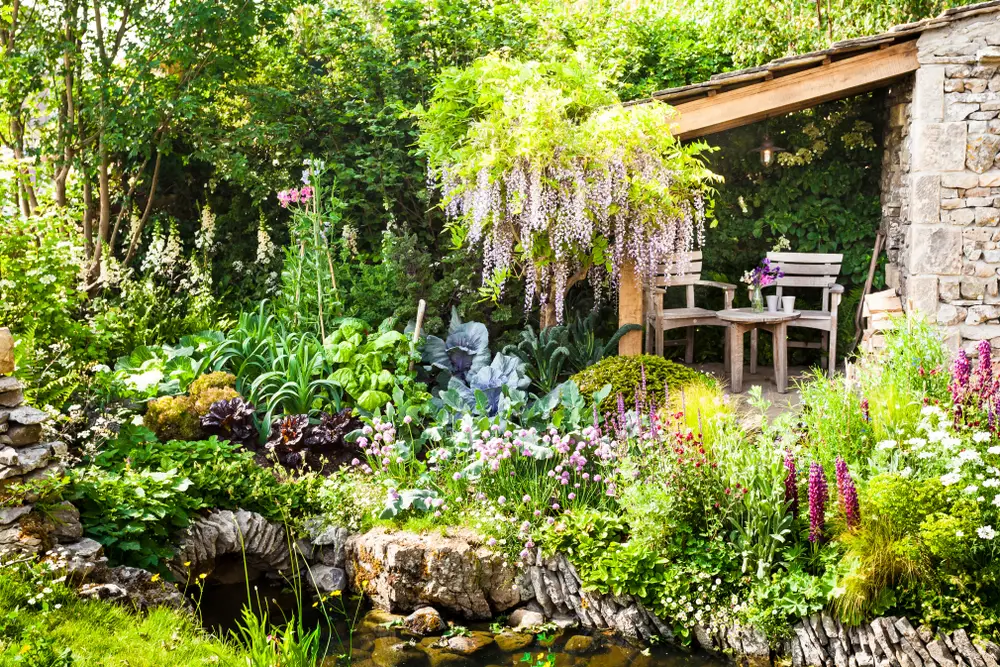
Shade in a garden shifts as the sun moves through the sky. The quality of shade is affected by many factors such as:
- Tree canopy
- Fences
- Buildings
It also changes from season to season, as the angle of the sun shifts in the sky.
If you’re a gardener, you’ll need to keep track of where the sun is – or isn’t – especially during the spring and summer months. This is the time when plants are actively growing. It’s also important to note how the light changes seasonally, from spring through fall.
The first thing to understand is that shade varies. It falls into three categories, each with subtle distinctions.
- Full Shade
- Part Shade
- Dappled Shade (filtered sun)
Gardeners should be familiar with these different categories of shade so that they can make the right plant choices for their gardens.
Full Shade
The term “full shade” refers to a spot that receives less than 4 hours of direct sun per day, with full coverage similar to the shadow under an umbrella. It’s also sometimes referred to as “dense shade” or “deep shade.” There aren’t very many plants that can grow well and thrive in these low-light conditions.
Bright Shade
These spots in a garden may not be as dark as they first appear. Nearby surfaces that reflect light can brighten up seemingly full-shade areas of a garden.
Consider the placement of these:
- White stucco walls
- Vinyl siding
- Large windows
- Paved areas, like driveways and cement patios
- Painted white fences
- A pond or swimming pool
If the sun shines directly on these surfaces, they reflect the light and can brighten up the surrounding shaded spots in the garden. Shady areas that receive a lot of reflected light are described as “bright shade” locations in a garden.
Bright shade can also describe open spots in the garden that are exposed to the open sky overhead (so you’d think they’d be sunny) but direct sun is blocked by buildings, a fence, or tall trees.
Part Shade/Semi-shade
The term “part shade” (or semi-shade) describes an area that receives 4-6 hours of direct sun in a day.
What’s also important, though, is what time of day the sun hits that area of the garden, in the morning or afternoon (or a bit of both.) That will affect how intense (strong) the sunlight is, how hot the area gets, and how well plants can tolerate the conditions.
Part Shade With Morning Sun
Morning sun is less intense than afternoon sun and the air temperatures are cooler. These areas are often east-facing garden beds.
Plants labeled “part shade” prefer the cooler conditions of morning sun and may struggle in the higher heat and intensity of afternoon sun.
Part Shade With Afternoon Sun
Afternoon sun is more intense than morning sun, and with it comes hotter air temperatures. While these locations are considered part shade (get 4-6 hours of direct sun) the light may be too intense for many shade plants.
“Part sun” is another term used to describe areas that are shaded in the morning but sunny in the afternoon. You will find plants labeled for “part sun” when they only need 4-6 hours of direct sun and can tolerate the afternoon heat.
The intensity of the afternoon sun depends on where you live. The further south, the more intense the afternoon sun will be. Garden areas that receive morning cover and afternoon sun are usually west-facing beds. In more northern regions, there isn’t as much difference between morning and afternoon sunlight, and plants suited for low light can tolerate either.
Part Shade With Morning & Late Afternoon Sun
We’ve already discussed that part shade means 4-6 hours of direct sun. However, this doesn’t need to be six consecutive hours. You might have spots in your garden that get two or three hours of sun in the morning, are shaded midday, and then receive sun again later in the afternoon. As long as the total hours of direct sunlight add up to 4-6, the area qualifies as part shade.
Dappled (Filtered) Shade
Sometimes an area in the garden doesn’t get direct sun all day, nor is it in full shade. Instead, it’s somewhere in between.
These are locations where sunlight is filtered (or diffused) all day into many small patches through the leaves of an open tree canopy. A lattice or picket fence or overhead pergola with closely-spaced beams also create filtered shade.
These areas do get some sun, but not as intensely as out in the open. In addition, the patches of sun are constantly shifting as the tree leaves move in the wind. In the case of a fence or pergola, the pattern of sun and shade changes as the sun moves through the sky.
Areas of dappled sun are also sometimes referred to as “filtered sunlight” or “light shade”.
How Do Plants Adapt To Shade?
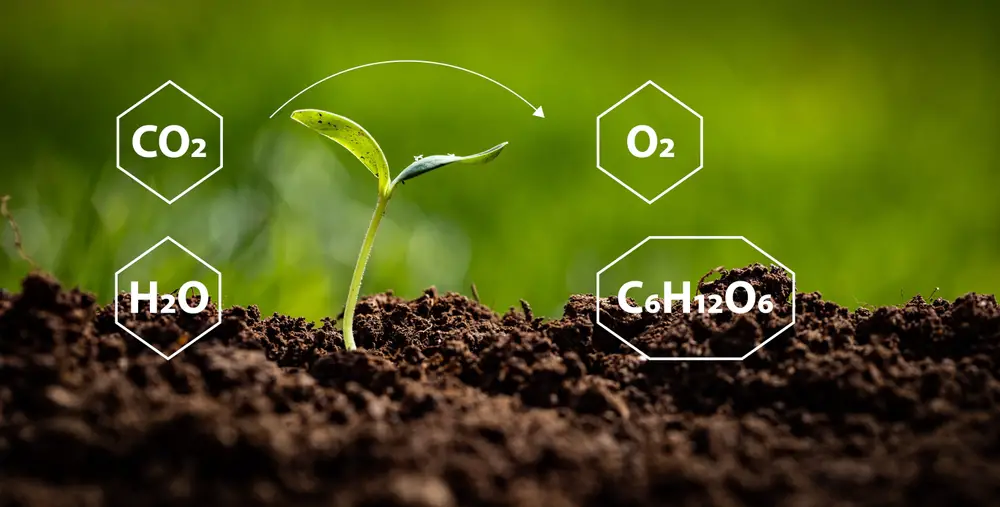
Most gardeners are familiar with the term “photosynthesis.” It’s the internal chemical process in which plants use carbon dioxide and water to manufacture their own food in the presence of sunlight. That’s the process that results in plants giving off the oxygen we breathe!
If you think of plants that grow in full sun, many of them have small thick leaves, or leaves with a waxy coating or fine fuzzy hairs (e.g. lavender, rosemary, sage). These coatings and smaller leaves enable the plant to withstand the sun’s intensity all day.
By contrast, plants that grow well in shade have larger and thinner leaves to capture as much energy from the sun as they can. In addition, they have adapted their internal cell structure and chemical makeup so that the process of photosynthesis can function efficiently in lower-light conditions.
Then there are spring-flowering plants with a strategy to take advantage of early spring sunshine under deciduous trees before the trees leaf out. These plants, growing beneath deciduous trees, are actually in full sun in spring. They harness this early sunlight to put on a burst of growth and flower before summer brings deeper cover. (See Ephemeral Spring-Flowering Plants)
Some flowering shrubs have adapted a similar strategy. Growing amongst deciduous trees, these shrubs flower in late winter or early spring (e.g. witch hazel, flowering daphne) before the tree canopy fills in.
How To Measure Your Garden’s Sun & Shade

Before making any design decisions or choosing plants for any spot in the garden, it’s important to take the time to watch and record how the sun moves across your garden throughout the day from season to season. That’s the only way to know where the sunny and shady areas are located. Without this information, you won’t know what plants will do well in different spots in your garden. The location of the summer sun is especially important.
You can purchase light meters to measure the sunlight for you, but they aren’t always reliable. Your best – and cheapest – bet is to set aside a day in early summer to observe your garden from sunrise to sundown. Or you can spread your observations over two days:
- Day 1: record the morning sun
- Day 2: make notes of the afternoon sun
For each area in your garden – or just the area you want to plant – make a note of where the sun is every hour. Write it down, draw a rough map to record the sun, or use your cell phone to take pictures of the same spot every hour so you can compare them later.
As a general rule, garden beds that face east receive cool morning sun and are shaded in the afternoon, while west-facing beds experience the opposite, with morning shade and hotter afternoon sun. North-facing beds—particularly those against a building wall—receive the least direct sun in a garden.
North-facing beds are good spots for plants that like full shade, while east-facing beds are the place to put plants labeled for part shade.
It’s also good to make a note of sun and shade in your garden in spring and fall. This will be good information if you’re considering growing early or late-season vegetables or spring-flowering shrubs.
Shade Garden Design Ideas
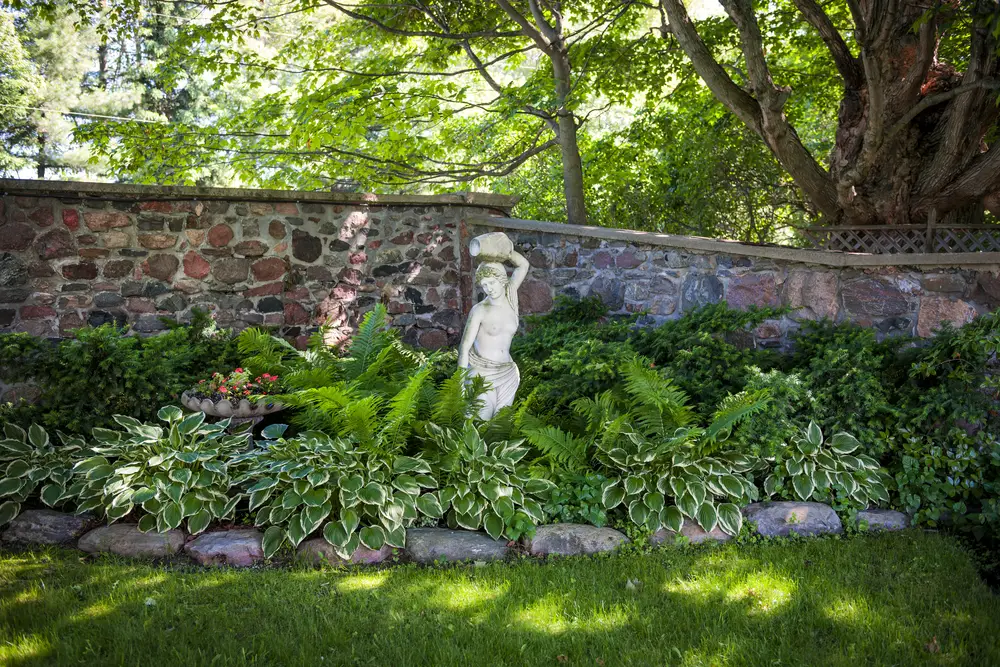
Designing a garden involves many of the same approaches as any other spot in the garden; for example, layering plants (the use of varying heights) and blending different leaf textures. But in shade gardens, attention to these details is even more important to give these spaces the visual impact that might otherwise be provided with bright sunlight and lots of colorful flowers.
Here are a few things to consider when designing for a shade garden:
- Use a variety of textures
- Use bright colored foliage and contrasting shades of green
- Include different plant heights to create layers
- Put like plants in groupings rather than a bunch of singles mixed together
- Repeat plants/colors for continuity and flow throughout the space
- Do away with lawn
- Use hardscaping to add visual interest and define planted areas
- Include containers
- Prune off low tree branches to increase light to deep shade areas
Use Different Textures
In most contexts, “texture” refers to the surface of an object. Is it smooth or rough? In a garden, texture refers to the visual appearance of different types of foliage, such as:
- Dense bunches of large leaves versus airy stems of small leaves or flowers
- Long softly arching grasses vs stiff upright shrubs
It’s all about the size and shape of the foliage and branches.
Using different textures brings visual interest to a garden, especially with a limited color palette. In a shade garden, where the choice of flower color is more limited, texture becomes even more important.
Strategic Use Of Color
The first plant characteristic that often comes to mind when thinking about garden design is color, and that’s usually of the flowers! When it comes to shade gardens, color is even more important to think about to brighten up dark spaces and create visual impact. However, the color in gardens is more often in the foliage rather than in flowers.
Foliage that is variegated (has more than one color) creates visual interest and helps to brighten a space in a shade garden as it reflects light. Leaves can feature variegation with green and creamy white to silver, yellow, or bright green. The spectrum of greens is almost endless, with bright chartreuse making a significant impact. These plants truly stand out in darker areas.
Shade gardens make a calmer and more elegant statement with monochromatic (single-color) themes. For example, using a combination of plants with creamy-white variegation, and white flowers. See Sample Plant Combinations below for more ideas.
Plant Groupings In Shade Gardens
To keep a shade garden from feeling too busy or chaotic looking, put plant varieties in groupings rather than singles dotted across the area. Depending on the size of the plants, a group could be as few as three. In larger areas, or along the border of a pathway it could be several plants.
This planting approach is called “mass planting” or “planting in drifts” and it creates larger blocks of the same plants with their unique color or texture. A combination of color blocks makes for a more impactful yet calm overall design than several different individual plants interplanted throughout a space. Think of a crazy quilt vs one with a block design.
Across a larger area, color blocks can be repeated for continuity and flow, and to draw the eye throughout the space.
Say Goodbye To The Lawn
There are a few turf grass varieties marketed as shade tolerant, but even these need at least 4 hours of sun (i.e., part shade) to grow well. In areas of bright or full shade, grass isn’t likely to be vigorous, and the turf will soon become patchy with moss.
Instead of settling for a mangy lawn area, replace the turf grass altogether. Many interesting and beautiful plants thrive in low light and require much less maintenance than turf grass!
Hardscaping
Visual interest can also be added to shade gardens with hardscaping and other decorative elements in addition to plants. Here are some ideas:
- Use wood chips, gravel or patio stones to create a meandering pathway that leads to a cement bench under a tree
- Build a small patio seating area in the afternoon shade to escape the hot afternoon sun
- Include a small water feature to attract birds. The sound of running water is also soothing and can also drown out surrounding urban sounds to make your garden more peaceful
- Tuck in cement statuary or metal works of art amongst the plantings to rise up out of the foliage
Prune Lower Tree Branches
Sometimes low-hanging branches on a large tree create dense shade. In addition, if they’re too low to walk under, you’re losing all that gardening space. It may be possible to prune off some of the lower branches (a term called “limbing up”) to make the space more accessible and to open it up to let in more light.
If you decide to limb up a tree, it’s always a good idea to consult a professional arborist first. They’ll be able to tell you if it’s feasible, and if taking off any tree branches will affect the health of the tree.
Creative Shade Gardening Techniques

Plant In Layers
When choosing plants for a shade garden, think about plants that have different heights to create layers of plantings. For example, plant a tall arching solomon’s seal (Polygonatum sp) with an underplanting of coral bells such as ‘Berrie smoothie’ (Heuchera ‘Berrie smoothie’) along with a groundcover of yellow-flowered fumewort (Corydalis lutea).
To add height to a the garden, use a tall trellis for a flowering clematis vine or grow a climbing hydrangea against a fence or brick wall.
Utilize Containers
A collection of containers can also be used to add interest to a shady area. So, consider including containers in the overall design. There are many different types of containers available, so you’re sure to find ones that suit your aesthetic. Some design ideas include:
- Color: Use different coloured planters to either make a bold splash or complement the foliage and flowers
- Plants: Plant them with colorful flowering annuals
- Height: Group containers of varying heights to create a focal point
- Texture: Use different materials to give added texture, such as
- Ceramic
- Wood
- Wicker
- Metal
- Design Features: decorative stones, statues, and art can be incorporated for interest
- Vertical Heights: consider adding trellises or obelisks
The added benefit of containers is that you can move them easily if the plants need to be relocated for more sun exposure.
Light
Incorporating lighting into your shade garden can transform the space. Consider using:
- Solar Lights: Install solar-powered garden lights along pathways or around seating areas. They also work to highlight specific plants or features
- Fairy Lights: Hang fairy lights around tree branches or in and out of taller plants for a magical touch. Use battery-operated or solar-powered fairy lights for flexibility
- Spotlights: Consider using spotlights to draw attention to standout plants or garden art
Plant Under Deciduous Trees
The dappled cover under deciduous trees is perfect for a garden. The only challenge is that many deciduous trees, particularly maples, beeches, and birches, are shallow-rooted, meaning their roots are very near the surface. These roots will out-compete smaller plants for nutrients and water, making conditions challenging for perennials and small shrubs.
So if you’re planting a shade garden under a shallow-rooted tree, choose plants that can tolerate drier conditions, such as barrenwort (Epimedium) or lungwort (pulmonaria). Or, be prepared to irrigate the garden more frequently.
Alternatively, create a series of planter boxes raised slightly off the ground to prevent tree roots from growing up and into the plantings. Deciduous trees such as oaks have deeper root systems. These trees won’t create root competition.
Shade Garden Maintenance Tips
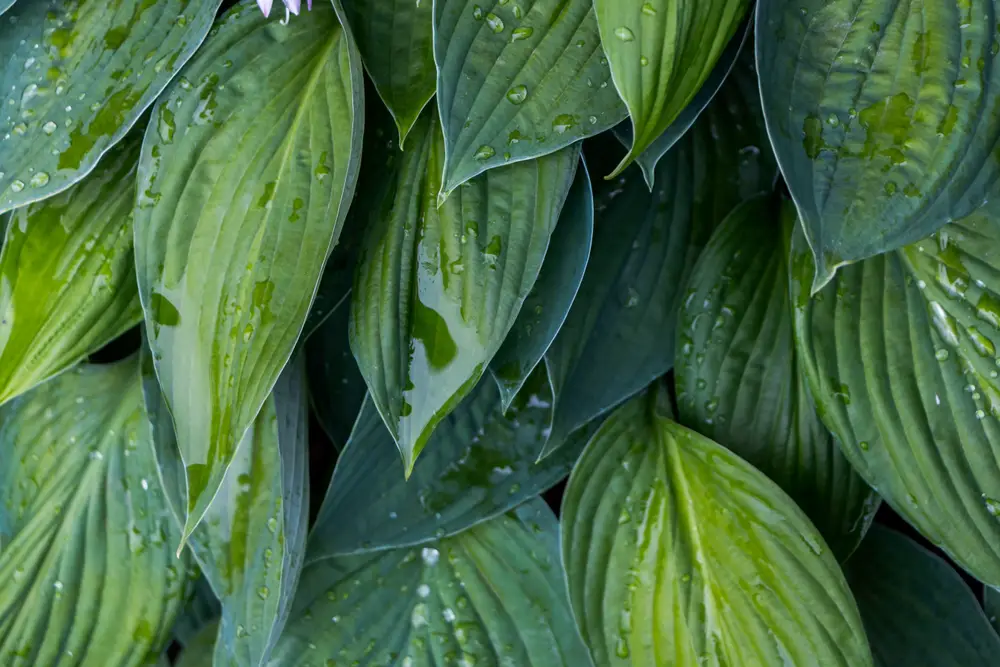
Watering
The soil in shaded gardens dries out more slowly than in full sun, so these beds need less frequent watering.
However, the soil under shallow-rooted trees will be drier because the roots absorb the moisture. These shallow roots will out-compete smaller garden plants for water, requiring you to water your garden more frequently. This is especially true if you haven’t chosen varieties that can tolerate dry conditions.
Remember, the canopy of a tree will block out rainfall just as it blocks out the sun! So, even if the rest of your garden gets a good soaking from the rain, you may need to water a shade garden under the trees.
Remember, try to water the soil and not the foliage. Wet foliage, especially in full shade areas, is more susceptible to fungal diseases. Try to water in the morning so that any moisture on the leaves will dry in the warm air and any direct sunlight.
Fertilizer
When planting a shade garden under a tree with shallow roots, these roots will outcompete your planted perennials for nutrients. So you’ll need to compensate by adding fresh compost or slow-release fertilizer to the beds to feed your perennials.
Choose The Best Plants For Shade
Choosing plants for a garden is a little bit like real estate: it’s all about location, location, location! You need to be familiar with the conditions in your garden and then choose the right plants for the right place.
Once you’ve identified the shady areas in your garden, you’ll be ready to choose some plants. Think about combinations of plantings using varieties from more than one of the following categories.
Evergreens For Shade
Evergreens are trees and shrubs that keep their foliage all year. The first thing you think of might be Christmas trees but there are actually two different groups of evergreens: Conifers and Broadleaf.
Conifers
Evergreen conifers have needle-like (e.g. pine, spruce) or scale-like (e.g. cedar) leaves and produce their seeds in woody cones. They can be very large trees – the ones that create the shade in your garden – but many varieties can be found that grow to sizes appropriate for smaller gardens.
These trees and shrubs add year-round interest to a garden, some with golden foliage and their unique overall shapes. Best of all, many can be grown in shade, including several varieties of yew and hemlock.
Broadleaf
Broadleaf evergreens have flat, often leathery or glossy, foliage. They all produce flowers, which can either be small and inconspicuous (e.g. boxwood and spotted laurel) or large and showy (e.g. camelia and rhododendrons).
Broadleaf evergreens add color to shaded areas with their flowers and add visual texture with their foliage. Examples of broadleaf evergreen shrubs include spotted laurel (Aucuba japonica), Leucothoe (Leucothoe sp), and rhododendrons.
Deciduous Trees & Shrubs
Large deciduous trees create cooling shadows in our gardens. Often called “shade trees,” they provide cover in the summer and, when they lose their leaves in winter, allow sunlight to warm our buildings.
These are usually the larger trees creating our shade garden in the first place, so not the ones we want to be adding. But there are several smaller varieties of deciduous trees that can enhance a shady spot in the garden, and some of them also flower.
One of the most popular deciduous trees for shade gardens is the Japanese maple. There are hundreds of varieties of Japanese maple, some grow to 10-15 feet (4-6 m) tall or more. Many more are dwarf varieties that max out at less than 6 feet (2.5 m). They’re perfect for smaller spaces or growing in containers.
Japanese maples grow best in USDA zones 5-8 and are a great choice to add spring and fall color to the shade garden. Many of them have attractive summer foliage to brighten up a shady area.
The twig dogwood shrubs (Cornus sp) make beautiful choices for the shade garden, but their claim to fame is the color of the twigs in winter. The bark on new growth turns bright red and golden yellow. Some can grow up to 10 feet (4 m), so they’re best placed towards the back of a bed to create a green backdrop for the rest of the plantings in summer. Their colorful twigs then add cheer to the dull winter landscape. The variegated red twig dogwood (Cornus alba ‘Elegantissima’) features green and white foliage, brightening dappled areas.
Flowering Trees & Shrubs
Many flowering trees and shrubs tolerate low light conditions, although some may not flower as abundantly as they do in full sun. In southern growing zones, where sunlight is more intense, these trees are excellent choices for areas with partial shade or morning sun, providing relief from the harsh afternoon sun. Some favorite flowering trees for these conditions include:
- Magnolias
- Flowering dogwoods
- Crape myrtle
Flowering shrubs don’t grow as tall and many are adapted to grow and flower in shade. There are both evergreen and deciduous options:
Evergreen Flowering Shrubs For Shade
- Lily-of-the-Valley shrub (Pieris japonica)
- Mountain laurel (Kalmia japonica)
- Rhododendrons and azaleas
- Oregon grape or holly grape (Mahonia aquifolium)
- Variegated winter daphne (Daphne odora ‘Aureomarginata’)
Deciduous Flowering Shrubs For Shade
- Hydrangea
- Japanese rose (Kerria japonica)
- Summersweet (Clethra alnifolia)
- Virginia sweetspire (Itea virginica)
- Witch hazel (Hamammelis spp.)
Perennials & Annuals For Shade
Many gardeners use a blend of annuals and perennials. Most flowering perennials have a limited window for their flower show (e.g. spring-flowering or fall-flowering) so if you want flower color all season, summer-flowering annuals will fit the bill.
Annuals
Annuals are plants that flower all summer, set seed, and die with the first frost. They need to be replaced each spring. They provide colorful flowers and foliage all season long, whereas most perennials have a flowering period that lasts only for a few weeks.
Flowering annuals such as begonias and fuchsias add color to a shade garden all season. They can be planted in spaces between perennials in the ground or in containers.
Another choice for annuals to provide color in shaded areas is coleus. These plants have foliage in color combinations ranging from bright green to orange, bright pink, and creamy white. They do flower, but it’s their foliage that adds pizzazz to the garden.
Perennials
Perennials are plants that come back year after year. Some have flowers, and others provide visual interest with their unique foliage. Choose perennials that will flower at different times so that you’ll always have something in flower during the growing season.
Perennials that grow in shade – not including some of the flowering shrubs – tend to have smaller flowers. So these plants make a bigger impact when planted in groups. For example, barrenwort (Epimedium sp) forms a groundcover of heart-shaped leaves, and in spring, it bears stems of small orchid-like flowers in colors from white to yellow, orange and pink.
If you live in southern climates where summer daytime temperatures can soar, flowering perennials that grow in full sun may flower for longer when grown in part shade because they aren’t subjected to intense mid-day sunshine.
Some perennials such as hostas are grown for their all-season show-stopping foliage rather than flowers. Likewise, ferns offer interesting foliage texture to a shade garden.
Ephemeral Spring-Flowering Plants
If you’ve ever walked in the woods in spring, before the deciduous trees have leafed out (grown in their new leaves), you will have enjoyed the variety of wildflowers and flowering bulbs blooming in the early spring sunshine. These plants are taking advantage of the full sun before the leaves fill in and cover them in shade.
Known as spring ephemeral plants (“ephemeral” means lasting for a very short time), they flower for a few weeks in the spring and then die back and go dormant once the tree canopy blocks the sun.
Some ephemerals are familiar spring flowering bulbs like crocus and daffodils, while others are native woodland plants that have been propagated for the commercial gardening market. These include:
- Shooting star (dodecathon meadia)
- Bloodroot (Sanguinaria canadensisI)
- Dutchman’s breeches (Dicentra cucullaria)
If you’d like to add spring-flowering woodland plants to your shade garden, seek them out at local garden centers or specialty native plant vendors. NEVER go out to the woods and dig them up to take home. In many cases, they won’t survive the transplant. More importantly, though, you’ll be destroying natural habitats and impacting ecological biodiversity.
Vegetables
Most vegetables need full sun (6-8 hours or more) to produce a good crop. However, there are some that can grow well in part shade. Most of them are cool season leafy greens, such as:
- Lettuce
- Kale
- Spinach
Root vegetables such as carrots and beets can also grow in part shade, but may not develop as fully as in full sun.
Colorful vegetables such as rainbow Swiss chard or the striking tall dark green lacinato kale can be used to add color and texture to a perennial shade garden.
Sample Plant Combinations For A Shade Garden
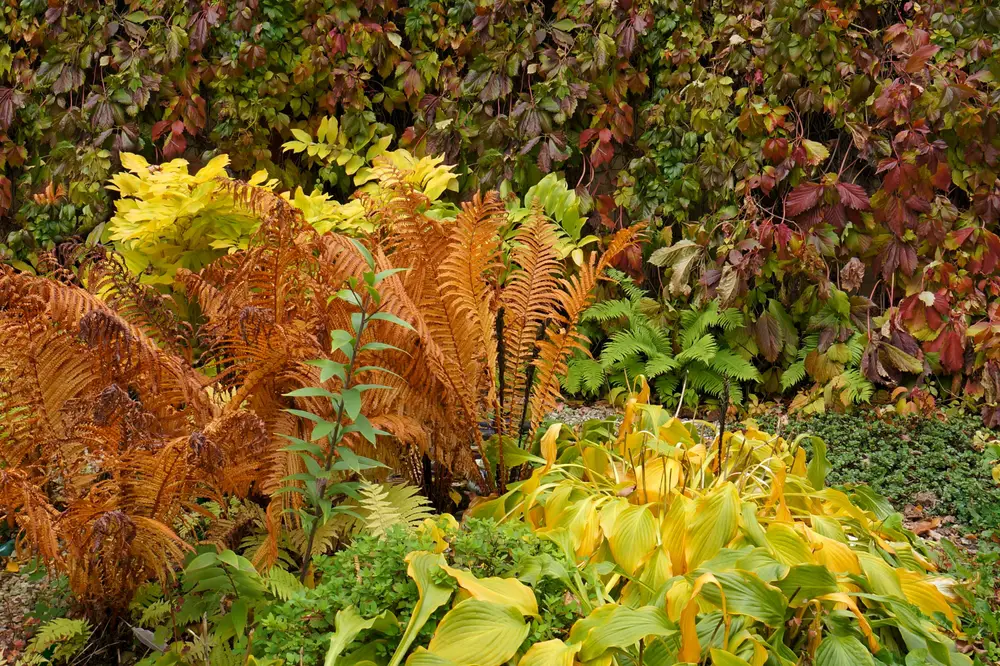
The plants you choose for your garden will depend on the type of light you’re working with—dappled to full. The following examples may or may not suit your specific circumstances, but they illustrate that these gardens are anything but dull! There are plenty of options for creating a beautiful space in low light.
Gorgeous Green
For visual contrast in hues of green, combine plants in various shades of green with different-shaped foliage, such as:
- Variegated hosta ‘Afterglow’ Has large dark green leaves edged with bands of chartreuse
- Christmas fern (Polystichum acrostichoides) Has glossy green leathery fronds growing in upright clusters
- Japanese forest grass (Hakonechloa macra) Has long arching blades of bright green with slightly darker green centre stripe. Planted this grass along a pathway or in containers where its arching fountain-like shape can be appreciated.
Outstanding Orange
You can also choose attractive color themes for your shaded areas. For example, if you like orange, consider this combo:
- Autumn fern (Dryopteris erythrosora ‘Brilliance). New growth comes in a brilliant coppery orange, slowly fading to bright green over the summer
- Cinnamon fern (Osmunda cinnamomea) Has classic lance-shaped foliage but also features upright narrow spikes of cinnamon-colored spore-producing structures that grow up from the centre of the plant
- Orange-leafed coral bell (Heuchera) such as ‘Amber waves’ or ‘Southern comfort’
Mellow Yellow
If you enjoy yellow, you might like this combo:
- Frances Williams hosta (Hosta sieboldiana ‘Frances Williams’) Has large blue-green leaves with irregular margins of greenish yellow
- Lady’s mantle (Alchemilla mollis) Has round scalloped-edged fuzzy leaves, and bears tall air clusters of small yellow-green flowers. Plant in masses for greater impact
- Fumewort (Corydalis lutea) Has fern-like green to blue-green foliage and bears clusters of small tube-shaped yellow flowers over a long season
Regal Purple & Silver
For a more subdued setting, try this silver and purple theme:
- Japanese painted fern (Athyrium niponicum) Has arching silvery fronds with deep purple midribs
- ‘Silver gumdrop’ coral bells (Heuchera ‘Silver gumdrop’) Has silvery iridescent leaves with dark purple veining and bears tall stems of small vibrant pink flowers
- Astilbe ‘Dark side of the moon’ Has dark chocolate-burgundy leaves and bears tall dense spikes of purple-pink flowers
FAQ
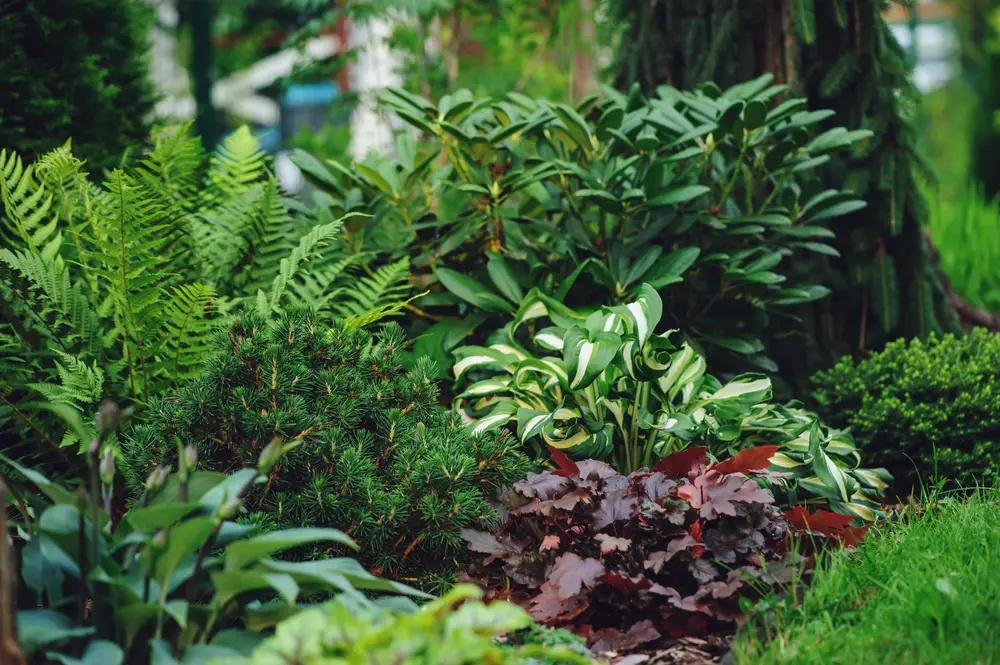
What Are The Best Flowers For A Shade Garden?
Flowering annuals such as begonias and fuchsias add color to a shade garden all season.
Other choices include:
- Impatiens
- Coral Bells
- Astilbe
- Barrenwort
Plants like coleus and hostas are mainly grown for their outstanding foliage but they also produce flowers.
Can You Grow Vegetables In The Shade?
Yes! Most are cool season leafy greens, such as:
- Lettuce
- Kale
- Spinach
- Arugula
But root vegetables such as carrots and beets also do well.
How Do I Create A Shade Garden In A Small Space?
Select dwarf or compact varieties of plants such as ferns, hostas, and small evergreens.
Take advantage of height by creating vertical gardens using trellises or living walls. Including hanging baskets is an additional way to make use of the small space.
Layering is another great technique. Plant tall plants at the back, medium plants in the middle, and groundcover plants beneath. This will add depth to even the smallest space.

